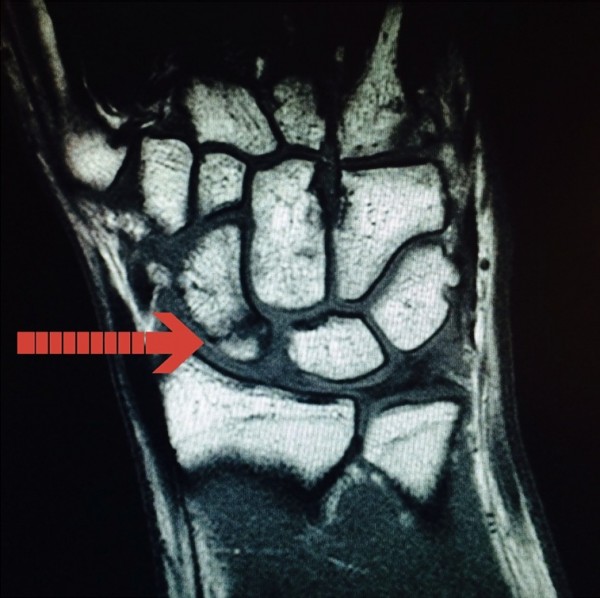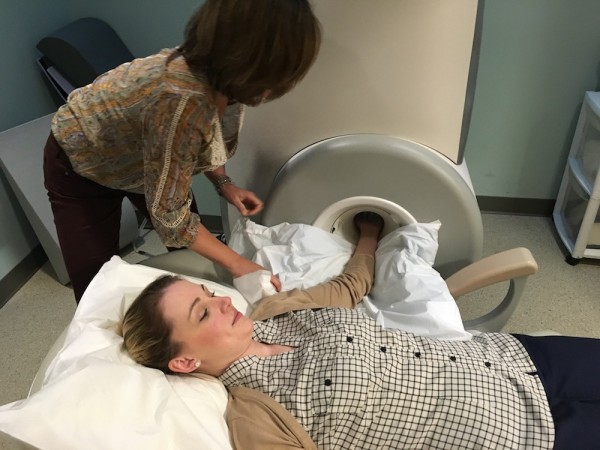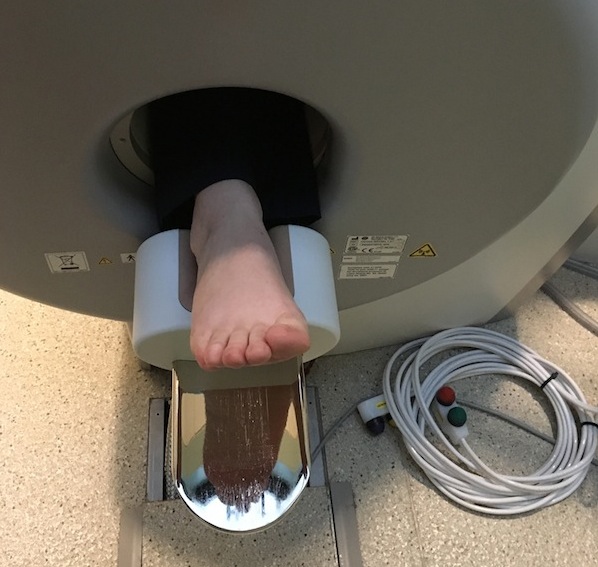This post is sponsored by Spectrum Medical Group
Last fall, Bowdoin College football quarterback Noah Nelson injured his wrist during a game. He’s in the white uniform. Number 18. It was around half-time in a game against Bates.
The picture above was taken at the moment he probably got hurt. Look closely and you can see his left wrist being bent backwards. It’s called an overextension injury. He may have been hurt, but it also looks as if Noah kept a firm grip on that football in his right hand!
He taped up his injured wrist and continued to play. Turns out he’d fractured one of the bones in his wrist. A tiny bone called the scaphoid, which sits at the base of the thumb. It may be tiny but he needed surgery. A pin to keep the bone stable, a cast for about six weeks and rehab for a couple of months.
An MRI that Noah had done at OA Centers for Orthopaedics in Portland showed the fracture clear as day. Follow the red arrow and you’ll see a dark ragged looking break with most of the bone above it and a fragment below. The image was taken with a fairly new type of MRI machine that is for extremities only — wrists, elbows, fingers, hands, feet, toes, some knees.
MRI stands for magnetic resonance imaging. The first successful MRI scan of a human being was done in 1977 — on a hand built machine! Today, MRIs are used regularly to produce highly accurate scans that help diagnose a wide variety of diseases and abnormalities throughout the body.
Unlike a CT scan, MRI doesn’t use radiation. I won’t go into great detail but in a nutshell, it uses a strong magnetic field and radio frequency pulsesIn to produce detailed images of organs and other structures inside the body.

If you’ve ever had an MRI, you know that you usually have to lie inside a large donut-shaped magnet like the one in the picture above. The machine produces cross sections or slices of the part of the body that is being scanned. The final result is a series of three-dimensional images. It is especially good for looking at soft tissues, as well as muscles, ligaments and tendons.
Noah did not have to lie inside the large MRI to get his wrist scanned. Instead, he rested in a recliner and stuck only his injured hand inside a smaller donut. It’s called an extremity MRI. I wanted to see how a patient might be positioned so with the help of “patient” Danielle Eaton, Tammy Belanger, OA’s MRI Center Manager, gave me a demonstration.
Extremities can be scanned with a conventional MRI, but Tammy says an extremity MRI is usually much easier for patients. “The best thing,” she says, “is that patients can remain reclining comfortably outside the magnet while only the part of the body we’re focusing on is placed in the center. It makes them feel much less anxious and decreases any claustrophobia immensely. That’s huge for patients. And it allows our technologists to obtain outstanding image quality.”
Danielle was kind enough to also demonstrate how a foot would fit into the machine. The recliner is turned to face the donut, and you stick your foot in part of the way or all the way, depending on what is being scanned.
Although smaller, the extremity MRI works the same way a conventional MRI does and the magnet is just as powerful. The cost is the same with either machine and both require pre-authorization by insurance carriers.
The amount of time needed to produce the high-quality images is also about the same. It can take 40 minutes or more. Patients often ask why they have to hold still the whole time. “MRI is very sensitive to motion,” Tammy explained. “We are looking at slices of anatomy that are one millimeter thick. We have to angle very specifically. If a patient moves even slightly, it has an effect. We use special sponges to help patients keep their position and also to make them more comfortable.”
Getting an accurate image of extremities, like Noah’s wrist, is much easier with the extremity MRI, without the discomfort some people experience being inside a larger machine. The goal is to get patients back in the game as soon as possible. It won’t be long before football season is here again and Noah Nelson will be in the game.
Disclosure
The Catching Health blog is my passion, but it requires a lot of time and energy researching topics, interviewing people and writing the posts. I recently started accepting sponsorships in order to generate some income. Spectrum Medical Group, a physician-owned multi-specialty practice, is a Catching Health sponsor. OA is a member of Spectrum. If you’d like to learn more about being a Catching Health sponsor, please send me an email.





Thank you so much on this informative article on extremity MRIs. It’s hard to get accurate information in health care these days. Your article answered all my questions. I need an MRI of my knee and was shocked to find out I would be in the tunnel! Even people working for the radiologist couldn’t answer my questions. The person scheduling appointments was unaware that Extremity MRI was an option at one of their locations even though it is on their website!
Betty, I’m so glad I could help!
Where can the extremities MRI for the band be found near Aiken SC